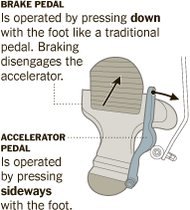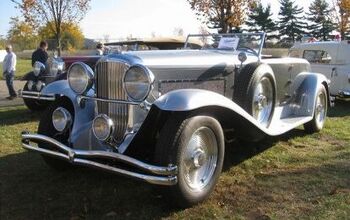Pedals For Dummies

Imagine yourself going down the road with your foot on the brake pedal all the time. This is a Japanese inventor’s idea to stop driver error and unintended acceleration. To accelerate, you move your foot sideways against an accelerator bar. To brake, you stomp on the brake. A horrible thought – if you are a personal injury lawyer.
“We have a natural tendency to stomp down when we panic,” says the inventor, Masuyuki Naruse. What’s more, in an accident, you are very likely to accelerate, because of the impact. In the split second it takes to change from gas to conventional brake pedal, with the new pedal, you are already braking.
There is little chance to hit the wrong pedal with the new setup.” When the pedal is pushed down, it always activates the brakes,” writes the New York Times.
Naruse developed the pedal 20 years ago, after he mistakenly stepped on the gas – as many others did, but often not admitted. Naruse did something about it. Natuse holds patents for the pedal in Japan, the United States and six other countries.
Naruse is not the only one who have designed a single pedal solution to prevent accidents caused by pedal misapplication. Regulators in Sweden are testing a single-pedal prototype by the inventor Sven Gustafsson.
Katsuya Matsunaga, an engineering and psychology specialist at Kyushu Sangyo University in Fukuoka City says: “Simply speaking, the conventional pedal setup, which forces drivers to switch back and forth between pedals, is dangerous. Mr. Naruse’s pedal works because it takes into account how our bodies work. It makes sure that when we make a mistake, the car stops.”
According to Naruse, Toyota engineers tested a prototype in 2000, but did not like the design. In May, Naruse invited Akio Toyoda, president of Toyota, to try a Lexus sedan fitted with the latest version of his pedal. Mr. Naruse said he had received no response.
Tip of the Skype to you-know-who.New York Times Video - Embed Player

Bertel Schmitt comes back to journalism after taking a 35 year break in advertising and marketing. He ran and owned advertising agencies in Duesseldorf, Germany, and New York City. Volkswagen A.G. was Bertel's most important corporate account. Schmitt's advertising and marketing career touched many corners of the industry with a special focus on automotive products and services. Since 2004, he lives in Japan and China with his wife <a href="http://www.tomokoandbertel.com"> Tomoko </a>. Bertel Schmitt is a founding board member of the <a href="http://www.offshoresuperseries.com"> Offshore Super Series </a>, an American offshore powerboat racing organization. He is co-owner of the racing team Typhoon.
More by Bertel Schmitt
Latest Car Reviews
Read moreLatest Product Reviews
Read moreRecent Comments
- AZFelix 2015 Sonata Limited72k when purchased, 176k miles currentlyI perform all maintenance and repairs except for alignment, tire mounting, tire patching, and glass work (tint and passenger left due to rock hit). Most parts purchased through rockauto.com.Maintenance and repairs during three years of ownership:Front rotors and all brake pads upgraded shortly after purchase.Preparing for 17th oil change (full synthetic plus filter c.$50), one PCV valve.Timing & accessory belts, belt tensioner.Coolant full flush and change.Fibrous plastic material engine under tray replaced by aftermarket solid plastic piece $110.One set of tires (c.$500 +installation) plus two replacements and a number of patches due to nails, etc. Second set coming soon.Hood struts $30.Front struts, rear shocks, plus sway bar links, front ball joints, tie rod ends, right CV axle (large rock on freeway damaged it and I took the opportunity to redo the rest of items on this list).Battery c.$260.Two sets of spark plugs @ $50/set.Three sets of cabin and engine filters.Valve cover gasket (next week).Averages out to c.$1400 per year for the past three years. Minor driver seat bolster wear, front rock chips, and assorted dents & dings but otherwise looks and drives very well.
- 3-On-The-Tree 2014 Ford F150 Ecoboost 3.5L. By 80,000mi I had to have the rear main oil seal replaced twice. Driver side turbo leaking had to have all hoses replaced. Passenger side turbo had to be completely replaced. Engine timing chain front cover leak had to be replaced. Transmission front pump leak had to be removed and replaced. Ford renewed my faith in Extended warranty’s because luckily I had one and used it to the fullest. Sold that truck on caravan and got me a 2021 Tundra Crewmax 4x4. Not a fan of turbos and I will never own a Ford again much less cars with turbos to include newer Toyotas. And I’m a Toyota guy.
- Duke Woolworth Weight 4800# as I recall.
- Kwik_Shift_Pro4X '19 Nissan Frontier @78000 miles has been oil changes ( eng/ diffs/ tranny/ transfer). Still on original brakes and second set of tires.
- ChristianWimmer I have a 2018 Mercedes A250 with almost 80,000 km on the clock and a vintage ‘89 Mercedes 500SL R129 with almost 300,000 km.The A250 has had zero issues but the yearly servicing costs are typically expensive from this brand - as expected. Basic yearly service costs around 400 Euros whereas a more comprehensive servicing with new brake pads, spark plugs plus TÜV etc. is in the 1000+ Euro region.The 500SL servicing costs were expensive when it was serviced at a Benz dealer, but they won’t touch this classic anymore. I have it serviced by a mechanic from another Benz dealership who also owns an R129 300SL-24 and he’ll do basic maintenance on it for a mere 150 Euros. I only drive the 500SL about 2000 km a year so running costs are low although the fuel costs are insane here. The 500SL has had two previous owners with full service history. It’s been a reliable car according to the records. The roof folding mechanism needs so adjusting and oiling from time to time but that’s normal.


































Comments
Join the conversation
It would be an interesting transition period while people got used to this new pedal system. Some guy is coming down the freeway on-ramp, suddenly notices that freeway traffic is moving faster than he thought and that he needs to accelerate briskly to merge smoothly, so he stomps on the pedal, panic stopping his car and possibly causing a chain reaction accident on the ramp. The installed base of drivers who expect separate pedals with the accelerator to the right and the brake to the left is much too large to retrain, no matter how effective this system might be (not that I think that it is).
Just reading about Naruse-San's invention made the tendons in my right leg twitch. I would argue that the current set-up is sub optimal. But we probably can't make a change while the there are substantial numbers of three pedal cars around. However, in a few years, the dual clutch transmissions will make the third pedal completely obsolete. I like the idea of putting the brake on the right side. I also like the idea of putting the throttle control on the steering wheel. I would also think that putting the brake on the right and the gas pedal on the left might reduce errors particularly if they were further apart than is current practice.